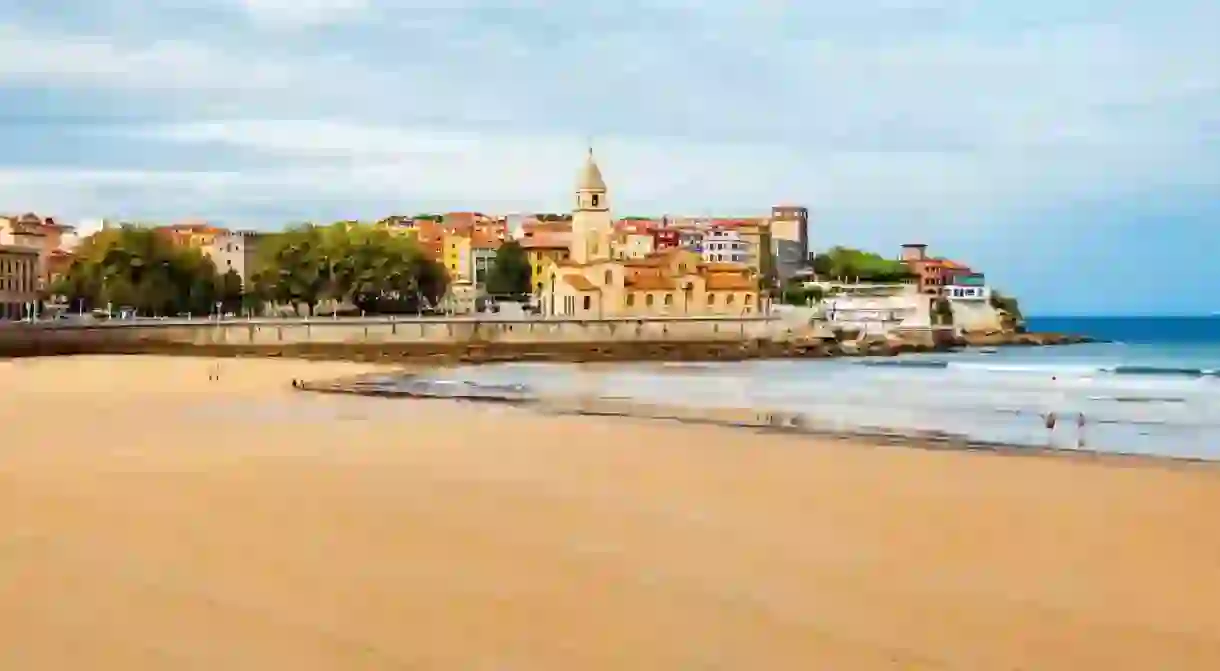Top Reasons Why You Should Visit Gijón, Spain

Trace a line along the wild Cantabrian coastline of Spain and you’ll find Gijón, a former fishing port on the Atlantic Ocean. Expect golden beaches like Playa de San Lorenzo, Roman ruins at Campo Valdés and top-quality local cider.
Gijón is the largest city in Asturias, the country’s premier cider-producing region. Often overlooked in favour of the regional capital of Oviedo (half an hour’s drive south), it nevertheless has plenty to engage the curious traveller, including dozens of boisterous sidrerías, superb seafood restaurants and great surfing beaches. Here are the best reasons why we think everyone should visit one of northern Spain’s most underrated destinations.
Try the local cider
Bar, Spanish

A good 80 percent of Spanish cider is produced in Asturias – and Gijón is right at the heart of it. Experience the deeply ingrained sidra culture in the city’s sidrerías (bars specialising in cider), where it’s poured into glasses from above-head height to generate bubbles and flavour. Among the best are La Costa, which also serves some of the tastiest grilled meat in town, and Casa Carmen, where you can sample Sidra Piñera, a locally made craft cider.
Visit the Roman baths
Archaeological site

The Campo Valdés Roman bath complex is one of the most important archaeological sites in northern Spain. Situated opposite San Pedro church in Gijón’s Old Town, the baths were built in the first and second centuries CE and unearthed in 1903, although not opened until 1965. There are two linked zones, one exploring Gijón’s Roman era and the other displaying remains of the cold, warm and hot rooms, as well as mosaics and artefacts found during their excavation.
See the world’s biggest oval church
Building

Gijón’s Universidad Laboral, a former orphanage, is the largest building in Spain and contains the world’s biggest oval church, with a marble floor that covers 800sqm (8,600sqft). Its 117m (384ft) belltower is the tallest stone building in Spain and was modelled on Seville’s Giralda cathedral. Wander around the church’s cavernous interior – now used primarily for cultural events – and take a lift to the top of the tower for views over the city and surrounding countryside.
Explore the golden beaches
Natural Feature

Gijón’s three city beaches are among the most attractive on the Asturian coast. The largest and busiest is Playa de San Lorenzo, a 1.5km (1mi) curve of sand, popular for swimming, surfing and paddle-boarding, backed by a bar-lined promenade. Half an hour’s walk east from here is the wilder Playa Cervigón, a cliffed-in cove that’s great for rock-pooling. The main beach on Gijón’s western side is the manmade Playa Arbeyal, a 500m (0.3mi) curve backing onto parks, restaurants and children’s playgrounds.
Admire the Elogio del Horizonte
Art Gallery

One of Gijón’s unique artistic attractions, this concrete sculpture occupies a clifftop in the Cerro de Santa Catalina Park. It was designed by Basque artist Eduardo Chillida and inaugurated in 1990. Stand inside the sculpture and listen carefully – it intensifies the sound of the waves hitting the rocks below. Take in unbroken views of the ocean to the north, and the city and mountains to the south. Reach the sculpture via a 15-minute walk from the centre of the Old Town.
Learn about the history of bagpipes
Museum
Although more readily associated with Scotland, bagpipe music has been an integral part of Asturian culture for centuries. Head to the International Bagpipe Museum to learn all about its connection with this part of Spain, and see a collection of bagpipes from elsewhere in Europe, Asia and Africa. It’s situated east of the Old Town, on the other side of the river. Opt for the audio guide for a more in-depth experience.
Surf the north coast’s epic beach breaks
Natural Feature

Gijón’s location on the Asturias coast makes it an ideal destination for surfing. Although sheltered by a western headland, the city’s main stretch of sand, Playa San Lorenzo, offers beginner and intermediate level waves in the winter, particularly on the west. For bigger, more consistent swells, even during the summer, drive half an hour west of Gijón to Playa de Xagó, one of the region’s best beach breaks.
Sample top seafood
Restaurant, Seafood

The waters off Gijón are teeming with species such as sardines, mackerel, hake, turbot, lobster and shrimp, making the city a must-visit if you love fish and seafood. Head to the Mercado del Sur to see and smell the day’s catch in its rawest form, or to one of the city’s best seafood restaurants to taste it. Top choices include El Restallu, a specialist in crustaceans and seafood-based rice dishes, and Casa Ataulfo, where you can pair Asturian cider with heaped plates of percebes (goose barnacles).













